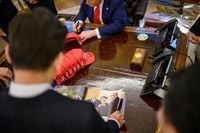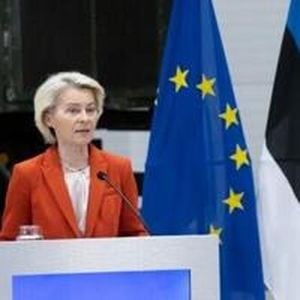On August 25, 2025, the White House in Washington, D.C. became the stage for a high-profile summit between South Korean President Lee Jae Myung and U.S. President Donald Trump. The event, which drew attention from both sides of the Pacific, was meticulously documented, with the White House releasing more than 40 official photographs on September 1 via its Flickr account. These images, snapped by the White House’s official photographer, offered an unusually detailed window into the mood, symbolism, and substance of the meeting between the leaders of two of the world’s most influential democracies.
From the outset, the photographs painted a picture of cordiality and mutual respect—despite the political drama that had preceded the encounter. According to Yonhap, one particularly memorable image showed President Trump greeting President Lee at the West Wing entrance, setting a tone of formality and welcome. The images then followed the leaders through the day, from the Oval Office to the Cabinet meeting room and beyond, capturing candid moments that spoke volumes about the summit’s atmosphere.
In one striking photo, President Lee stands between his chief of staff Kang Hoon-sik and his interpreter, gesturing animatedly as he explains a point to President Trump. The interpreter, positioned to Lee’s left, was tasked with translating and delivering Lee’s remarks in real time—a reminder of the linguistic and cultural bridges that must be crossed in global diplomacy. This image, highlighted by both Yonhap and MK News, seemed to encapsulate Lee’s “pragmatic” diplomatic approach, which he has described as the foundation of his administration’s foreign and security policy.
The summit was not short on symbolism. On the Resolute Desk—a historic centerpiece of the Oval Office—sat several red “Make America Great Again” hats, Trump’s signature campaign slogan. According to MK News, Trump personally autographed these hats to present as gifts to President Lee and his South Korean counterparts. One photograph captured the moment as Trump sat at his desk, signing a hat, while President Lee looked on, examining a photo book that Trump had just handed him. The gesture, though lighthearted, was heavy with political meaning, reflecting both the personal and institutional ties that bind the two nations.
Another memorable image showed President Trump speaking to President Lee and Chief Kang, his hands extended forward in a gesture of emphasis. The conversation, though private, was clearly intense, with both sides engaged in what appeared to be a serious exchange of ideas. The body language in the photos—firm handshakes, shared smiles, and attentive listening—suggested a genuine effort to find common ground on issues ranging from security to trade and technology.
Perhaps the most telling symbol of the summit’s tone was found in a guest book message penned by President Lee. As captured in the White House’s photo release and reported by Yonhap, Lee wrote: “In the golden era of the South Korea-US alliance, a strong and great future starts anew.” The message, both optimistic and forward-looking, underscored Lee’s commitment to the alliance, which he has repeatedly described as the bedrock of South Korea’s security and prosperity.
The summit’s guest list was a who’s who of top officials from both countries. In addition to President Trump and President Lee, attendees included U.S. Vice President J.D. Vance, Commerce Secretary Howard Lutnick, South Korean Foreign Minister Cho Hyun, National Security Advisor Wi Sung-lac, and Industry Minister Kim Jung-kwan. The presence of these high-ranking figures highlighted the summit’s significance and the breadth of topics under discussion.
As the meeting progressed, the leaders and their teams moved from the Oval Office to the White House Cabinet meeting room for a luncheon. There, another photograph captured Lee, Foreign Minister Cho Hyun, and Industry Minister Kim Jung-kwan seated with the Korean and American flags in the background, a visual reminder of the enduring partnership between the two nations. The luncheon, while less formal than the preceding talks, provided an opportunity for more relaxed conversation and further cemented the personal rapport between the delegations.
Media coverage of the summit was also on display during the meeting. According to MK News, one photo showed President Trump pointing at an Oval Office TV monitor broadcasting Fox News coverage of the summit. The image captured the intersection of diplomacy and media spectacle—a dynamic that has become increasingly central to international relations in the social media age.
Despite the summit’s warm atmosphere, it was not without its tensions. Observers noted, as Yonhap reported, that the meeting took place in the shadow of a pre-summit social media post by President Trump that had been critical of the Lee administration. Yet, by all accounts, the summit itself proceeded smoothly, with both leaders putting aside public disagreements in favor of constructive dialogue. The images released by the White House seemed to reinforce this narrative, focusing on moments of collaboration and goodwill rather than discord.
The summit’s agenda was ambitious. Both sides sought to enhance cooperation on a range of issues, including security, trade, and technology. President Lee, who has made the U.S.-South Korea alliance a cornerstone of his foreign policy, was keen to demonstrate his administration’s commitment to deepening ties with Washington. President Trump, for his part, appeared eager to showcase his ability to foster strong relationships with key allies, even as his administration continues to pursue an “America First” approach to international affairs.
For South Korea, the stakes were particularly high. The country faces ongoing security challenges from North Korea, as well as economic and technological competition from regional powers. Strengthening the alliance with the United States is seen as essential to maintaining stability and advancing South Korea’s interests on the global stage. The summit provided an opportunity for President Lee to reaffirm his country’s commitment to this partnership, while also seeking assurances from Washington on issues of mutual concern.
For the United States, the meeting offered a chance to reinforce its leadership role in East Asia and to signal its continued support for democratic allies. The presence of Vice President Vance and Commerce Secretary Lutnick underscored the administration’s focus on both security and economic cooperation. The summit also provided a platform for President Trump to demonstrate his diplomatic credentials and to project an image of strength and unity to both domestic and international audiences.
In the aftermath of the summit, analysts and observers were largely positive in their assessments. The release of the official photographs was seen as an effort to highlight the personal rapport between the leaders and to reassure both publics of the alliance’s vitality. As Yonhap noted, many of the photos “captured the cordial mood of the summit—a high-stakes meeting where Lee and his staff sought to make successful as South Korea sought to enhance bilateral cooperation on security, trade, technology and other areas.”
Ultimately, the summit between President Lee Jae Myung and President Donald Trump served as a vivid reminder of the enduring importance of the U.S.-South Korea alliance. Through a blend of symbolism, substance, and carefully choreographed photo ops, both leaders sought to send a clear message: the partnership remains strong, resilient, and ready to face the challenges of a new era together.




